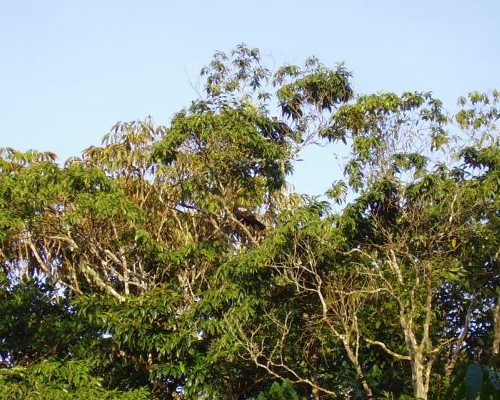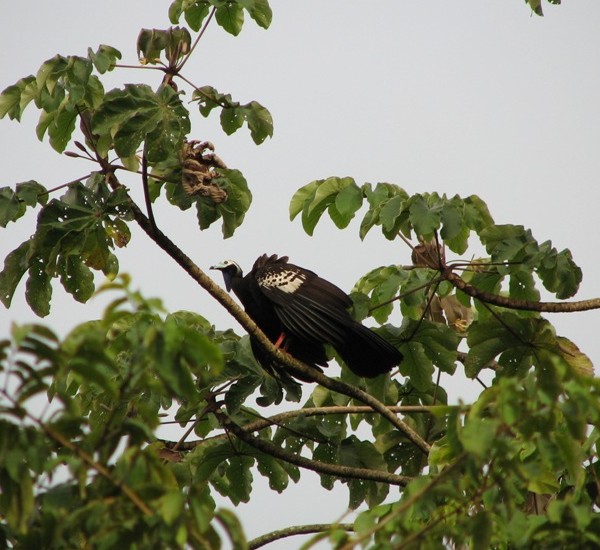 The Trinidad piping-guan (Pipile pipile) is the only species of bird endemic to the
island of Trinidad. It is a medium sized cracid galliform locally known as the "pawi" and is
at risk of extinction because of hunting and habitat loss. It is listed as Critically
Endangered on the IUCN Red List and of Immediate Conservation Priority on the IUCN Cracid
Specialist Group Action Plan. The pawi is now known only from about 150 km2 of
suitable habitat
in the eastern portion of the Northern Range in Trinidad, with a population thought to be lower
than 200 birds (BirdLife International, 2000). Temple (1998) reported that illegal hunting is
the overriding threat to the species, and that its status had deteriorated significantly during
the preceding 10 years. James and Hislop (1988) reviewed the status of the pawi and conservation
measures taken to that time. The pawi was listed as one of the highest priorities for action in
the Cracid Action Plan for 2000-2004 (Brooks and Strahl, 2000), and both the Environmental
Management Authority (EMA) and the Wildlife Section of the Division of Forestry have identified
the pawi as a species of particular interest. It is one of the first three Environmentally
Sensitive Species listed by the EMA.
The Trinidad piping-guan (Pipile pipile) is the only species of bird endemic to the
island of Trinidad. It is a medium sized cracid galliform locally known as the "pawi" and is
at risk of extinction because of hunting and habitat loss. It is listed as Critically
Endangered on the IUCN Red List and of Immediate Conservation Priority on the IUCN Cracid
Specialist Group Action Plan. The pawi is now known only from about 150 km2 of
suitable habitat
in the eastern portion of the Northern Range in Trinidad, with a population thought to be lower
than 200 birds (BirdLife International, 2000). Temple (1998) reported that illegal hunting is
the overriding threat to the species, and that its status had deteriorated significantly during
the preceding 10 years. James and Hislop (1988) reviewed the status of the pawi and conservation
measures taken to that time. The pawi was listed as one of the highest priorities for action in
the Cracid Action Plan for 2000-2004 (Brooks and Strahl, 2000), and both the Environmental
Management Authority (EMA) and the Wildlife Section of the Division of Forestry have identified
the pawi as a species of particular interest. It is one of the first three Environmentally
Sensitive Species listed by the EMA.
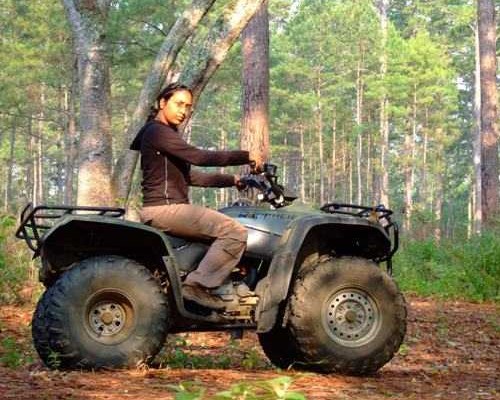 The University of the West Indies, St. Augustine has been involved with research on the pawi
since 2004, as part of the Pawi Study Group (PSG).
Kerrie Naranjit did a short study of
the habitat use of the pawi as her B.Sc. research project in spring 2005, and was a participant
on Project Pawi later that summer. Project Pawi was organised by Aidan Keane, who
received a Gold Award from the BP Conservation Programme (BPCP) for this survey of the current
distribution of the pawi, in collaboration with the PSG. Kerrie Naranjit was selected to attend
the BPCP Training Course (Monitoring and Assessment of Biodiversity Program) at the Smithsonian
National Zoological Park Conservation and Research Center, Virginia in June 2005. Subsequently
a grant from the American Bird Conservancy (William Belton Small Grants Fund) and the
Conservation International Foundation was obtained by
the PSG to continue this work in the form of an M.Phil. studentship. The EMA agreed to provide
a stipend for the studentship, and Kerrie Naranjit was appointed and began field work in
January 2007. Through her association with Project Pawi, and participation in another BPCP
project on the Bloody Bay frog in Tobago in 2006, Kerrie obtained a BPCP Alumnus Grant to
attend the Tall Timbers field station in Florida in May 2007. There she received three weeks
training in radiotracking and capture of wild galliform birds from Dr John Carroll and his
research group. Many of these initiatives have been facilitated by help from the
World Pheasant Association,
Fordingbridge, UK.
The University of the West Indies, St. Augustine has been involved with research on the pawi
since 2004, as part of the Pawi Study Group (PSG).
Kerrie Naranjit did a short study of
the habitat use of the pawi as her B.Sc. research project in spring 2005, and was a participant
on Project Pawi later that summer. Project Pawi was organised by Aidan Keane, who
received a Gold Award from the BP Conservation Programme (BPCP) for this survey of the current
distribution of the pawi, in collaboration with the PSG. Kerrie Naranjit was selected to attend
the BPCP Training Course (Monitoring and Assessment of Biodiversity Program) at the Smithsonian
National Zoological Park Conservation and Research Center, Virginia in June 2005. Subsequently
a grant from the American Bird Conservancy (William Belton Small Grants Fund) and the
Conservation International Foundation was obtained by
the PSG to continue this work in the form of an M.Phil. studentship. The EMA agreed to provide
a stipend for the studentship, and Kerrie Naranjit was appointed and began field work in
January 2007. Through her association with Project Pawi, and participation in another BPCP
project on the Bloody Bay frog in Tobago in 2006, Kerrie obtained a BPCP Alumnus Grant to
attend the Tall Timbers field station in Florida in May 2007. There she received three weeks
training in radiotracking and capture of wild galliform birds from Dr John Carroll and his
research group. Many of these initiatives have been facilitated by help from the
World Pheasant Association,
Fordingbridge, UK.
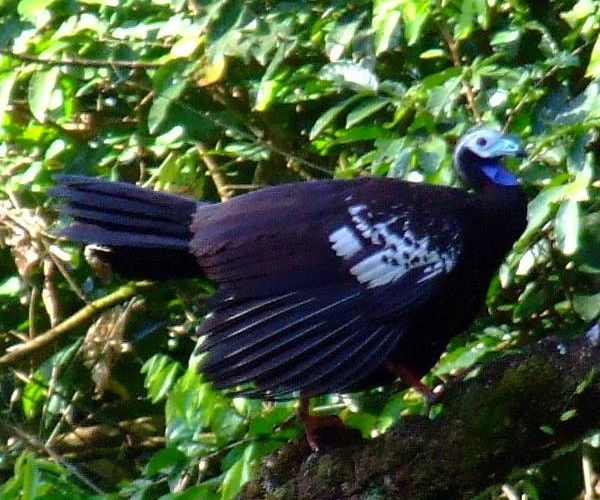 Work on the distribution and status of the pawi, and active conservation measures, are
continuing by the PSG. The particular focus of the M.Phil. studentship is the population
biology of the pawi, in particular at a field site in Grande Riviere in the eastern Northern
Range, and a control site at Morne Bleu in the central Northern Range. Alexander (2002) has
highlighted how little information is known about the pawi, including the seasonality of
breeding and the location of nesting sites. The M.Phil. project is developing a photographic
method of individual recognition (based on the white wing coverts) so that the behaviour of
identifiable individuals can be
catalogued. The project will describe the phenology of behaviour, and aspects such as home
ranges more directly related to conservation. Radiotracking will be used when wild pawi can be
caught safely, with the latter being the major consideration. Kerrie Naranjit has received a
thorough training program in handling galliform birds, including a captive pawi, through the
PSG. The assistance of many volunteer field workers, mostly from
Trinidad, has also been essential to the success of the project.
Kerrie gave a presentation on the pawi project at the Fifth International Galliformes Symposium
of the World Pheasant Association, Chiang Mai, Thailand, in
November 2010 (see also Naranjit, 2010).
Work on the distribution and status of the pawi, and active conservation measures, are
continuing by the PSG. The particular focus of the M.Phil. studentship is the population
biology of the pawi, in particular at a field site in Grande Riviere in the eastern Northern
Range, and a control site at Morne Bleu in the central Northern Range. Alexander (2002) has
highlighted how little information is known about the pawi, including the seasonality of
breeding and the location of nesting sites. The M.Phil. project is developing a photographic
method of individual recognition (based on the white wing coverts) so that the behaviour of
identifiable individuals can be
catalogued. The project will describe the phenology of behaviour, and aspects such as home
ranges more directly related to conservation. Radiotracking will be used when wild pawi can be
caught safely, with the latter being the major consideration. Kerrie Naranjit has received a
thorough training program in handling galliform birds, including a captive pawi, through the
PSG. The assistance of many volunteer field workers, mostly from
Trinidad, has also been essential to the success of the project.
Kerrie gave a presentation on the pawi project at the Fifth International Galliformes Symposium
of the World Pheasant Association, Chiang Mai, Thailand, in
November 2010 (see also Naranjit, 2010).
Work on the pawi has to be done in conjunction with local communities, as threats to this bird
are directly anthropogenic. The principal study population at Grande Riviere is in an area
where good relations have already been developed with the local community, including the recent
hosting of a workshop on conservation of the pawi and sea turtles in the area (September 2006).
There is incipient ecotourism based on the pawi, which the local community is seeking to
develop to follow that on sea turtles. There is concern that visitors to observe the pawi
currently do not generally contribute to the economy of the local community. Information on the
pawi gained during this project will be used to develop materials for locally-based
ecotourism.
Ecotourists watching pawi, Kerrie Naranjit at left; a typical view of wild pawi
(two birds, centre and top)
Funding
- TT$ 100,000 (2 years), Environmental Management Authority, Trinidad and Tobago, for an
M.Phil. studentship on the pawi.
- US$ 5,000 (2005), American Bird Conservancy (William Belton Small Grants Fund), USA, and
Conservation International Foundation, for support
of work by M.Phil. student in association with the Pawi Study Group, St. Augustine.
- US$ 1,150 (2007), BP Conservation Programme, USA, Alumnus Grant to Kerrie Naranjit to attend
training in radiotracking galliform birds, Tall Timbers Research Station.
- TT$ 14,000 (2010), Campus Research and Publication Fund, Student Travel Grant, part-funding to attend the
Fifth International Galliformes Symposium of the World Pheasant Association, Chiang Mai, Thailand,
November 2010.
- US$ 1,250 (2010), BP Conservation Programme, USA, Alumnus Grant to Kerrie Naranjit to support attendance
of the Fifth International Galliformes Symposium of the World Pheasant Association, Chiang Mai, Thailand,
November 2010.
Supervision
- Chief supervisor: Dr Adrian Hailey, Department of Life Sciences, University of the West
Indies, St. Augustine.
- Co-supervisor: Prof. John E. Cooper, formerly of the School of Veterinary Medicine, University of the West
Indies, St. Augustine (Mount Hope Campus). (Welfare)
- Advisor: Prof. John P. Carroll, Warnell School of Forestry and Natural Resources,
University of Georgia, Athens, USA. (Galliform Ecology)
Results
-
Naranjit, K.T. (2012). Phenology of the Trinidad Piping-guan, Pipile pipile.
Thesis,
Department of Life Sciences, The University of the West Indies, St. Augustine, x+222 pp. M.Phil. in
Environmental Biology awarded 2013.
-
Naranjit, K. (2011). Management and Recovery Plan for the Trinidad Piping-guan, Pipile pipile.
Final report to the Environmental Management Authority, 42 pp.
Department of Life Sciences, The University of the West Indies, St. Augustine.
-
Nelson, H.P., Devenish, C., Bobb-Prescott, N., Naranjit, A., Naranjit, K. and McGowan, P.J.K. (Eds). (2011).
Pawi Species Recovery Strategy. Report, 22 pp. The Pawi Study Group, World Pheasant Association and Bird Life
International.
download
-
Naranjit, K. (2010). Knowledge of the Critically Endangered pawi continues to increase. Annual
Review of the World Pheasant Association 2009/2010, p 31. Newcastle upon Tyne, UK.
download
-
Naranjit, K. (2009). Handbook of Field Methodologies for Trinidad Piping-guan Field Studies.
Report to the Environmental Management Authority, 39 pp.
Department of Life Sciences, The University of the West Indies, St. Augustine.
References
Alexander, G.D. (2002). Observations of the endangered Trinidad piping-guan (Pipile
pipile), or Pawi, in northern Trinidad. In Studies in Trinidad and Tobago ornithology
honouring Richard ffrench. Eds F.E. Hayes & S.A. Temple. Department of Life Sciences,
University of the West Indies, St. Augustine, Trinidad and Tobago, Occ. Paper 11, p 119-130.
BirdLife International (2000). Lynx Ediciones, Barcelona, Spain.
Brooks, D.M. and Strahl, S.D. (2000). Curassows, Guans and Chachalacas: Status Survey and
Conservation Action Plan; IUCN, Gland, Switzerland and Cambridge, UK.
James, C and Hislop, G. (1998). Status and Conservation of Two Cracid Species, the Pawi on
Trinidad Piping-Guan (Pipile pipile) and the Cocrico (Ortalis ruficanda) in
Trinidad and Tobago. Forestry Division, Trinidad.
Naranjit, K. (2010). Knowledge of the Critically Endangered pawi continues to increase. Annual
Review of the World Pheasant Association 2009/2010, p 31. Newcastle upon Tyne, UK.
Temple, S.A. (1998). The status of Pipile pipile in Trinidad. In Biology of the piping
guans (Aves: Cracidae), Eds D.M. Brooks, F. Olmos & A.J. Begazo, p 13. Special Publication of
the Cracid Specialist Group, No. 1. Houston, Texas, USA.

The Pawi Study Group, St. Augustine
Ecological and behavioural research on the pawi is conducted in association with the Pawi
Study Group, St. Augustine (PSG).
The PSG is a multidisciplinary group established in 2004,
under the original chairmanship of Professor John E. Cooper of the School of Veterinary
Medicine, University of the West Indies, Trinidad. The Pawi Study Group's mission
is "To increase knowledge and understanding of the endemic and endangered Trinidad piping-guan
while promoting the conservation of this bird and its habitat through awareness raising and
public support". The PSG involves staff and students
from other Faculties as well as personnel from the Asa Wright Nature Centre, the Emperor Valley
Zoo, the Trinidad & Tobago Field Naturalists' Club and other organisations. Close contact is
maintained with the government's Wildlife Section and the Environmental Management Authority,
especially regarding legal and ethical aspects of the work. The group is currently chaired by
Kerrie Naranjit. A novel part of the group's work is that it involves both
zoologists and veterinarians. The veterinary side of the study concentrates on assessing
the health of the remaining pawi population. Remarkably little is known about the
susceptibility of this species to infectious diseases and yet it is well recognized that
viruses, bacteria and parasites can readily decimate small isolated populations of birds.
Initial studies on sampling methods are being carried out on captive pawi.
Through the assistance of the World Pheasant Association the PSG has obtained
two grants, of US$4,000 from Conservation International (CI) and US$5,000 from the American Bird
Conservancy and CI, for work on the pawi.
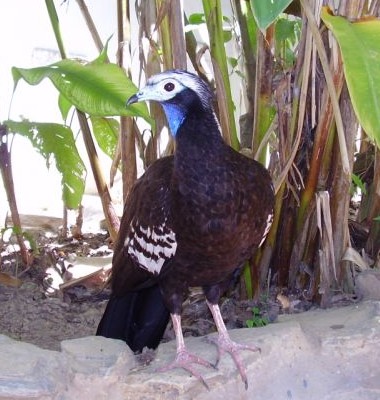
| 
|
The pawi at the Emperor Valley Zoo, Port of Spain (died 2007); Dr Nadin Thompson swabbing the
zoo pawi
The PSG is particularly keen to hear from people who have had experience of the pawi in the
wild or in captivity, or have information on its biology or health, or are aware of study skins,
eggshells or other specimens in museums or elsewhere that might be available for study. Please
contact them through the Chair,
Kerrie Naranjit, or see their new website
PSG link.
 The Trinidad piping-guan (Pipile pipile) is the only species of bird endemic to the
island of Trinidad. It is a medium sized cracid galliform locally known as the "pawi" and is
at risk of extinction because of hunting and habitat loss. It is listed as Critically
Endangered on the IUCN Red List and of Immediate Conservation Priority on the IUCN Cracid
Specialist Group Action Plan. The pawi is now known only from about 150 km2 of
suitable habitat
in the eastern portion of the Northern Range in Trinidad, with a population thought to be lower
than 200 birds (BirdLife International, 2000). Temple (1998) reported that illegal hunting is
the overriding threat to the species, and that its status had deteriorated significantly during
the preceding 10 years. James and Hislop (1988) reviewed the status of the pawi and conservation
measures taken to that time. The pawi was listed as one of the highest priorities for action in
the Cracid Action Plan for 2000-2004 (Brooks and Strahl, 2000), and both the Environmental
Management Authority (EMA) and the Wildlife Section of the Division of Forestry have identified
the pawi as a species of particular interest. It is one of the first three Environmentally
Sensitive Species listed by the EMA.
The Trinidad piping-guan (Pipile pipile) is the only species of bird endemic to the
island of Trinidad. It is a medium sized cracid galliform locally known as the "pawi" and is
at risk of extinction because of hunting and habitat loss. It is listed as Critically
Endangered on the IUCN Red List and of Immediate Conservation Priority on the IUCN Cracid
Specialist Group Action Plan. The pawi is now known only from about 150 km2 of
suitable habitat
in the eastern portion of the Northern Range in Trinidad, with a population thought to be lower
than 200 birds (BirdLife International, 2000). Temple (1998) reported that illegal hunting is
the overriding threat to the species, and that its status had deteriorated significantly during
the preceding 10 years. James and Hislop (1988) reviewed the status of the pawi and conservation
measures taken to that time. The pawi was listed as one of the highest priorities for action in
the Cracid Action Plan for 2000-2004 (Brooks and Strahl, 2000), and both the Environmental
Management Authority (EMA) and the Wildlife Section of the Division of Forestry have identified
the pawi as a species of particular interest. It is one of the first three Environmentally
Sensitive Species listed by the EMA.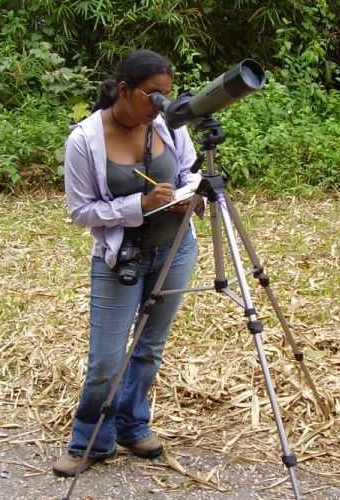
 The University of the West Indies, St. Augustine has been involved with research on the pawi
since 2004, as part of the
The University of the West Indies, St. Augustine has been involved with research on the pawi
since 2004, as part of the  Work on the distribution and status of the pawi, and active conservation measures, are
continuing by the PSG. The particular focus of the M.Phil. studentship is the population
biology of the pawi, in particular at a field site in Grande Riviere in the eastern Northern
Range, and a control site at Morne Bleu in the central Northern Range. Alexander (2002) has
highlighted how little information is known about the pawi, including the seasonality of
breeding and the location of nesting sites. The M.Phil. project is developing a photographic
method of individual recognition (based on the white wing coverts) so that the behaviour of
identifiable individuals can be
catalogued. The project will describe the phenology of behaviour, and aspects such as home
ranges more directly related to conservation. Radiotracking will be used when wild pawi can be
caught safely, with the latter being the major consideration. Kerrie Naranjit has received a
thorough training program in handling galliform birds, including a captive pawi, through the
PSG. The assistance of many volunteer field workers, mostly from
Trinidad, has also been essential to the success of the project.
Kerrie gave a presentation on the pawi project at the Fifth International Galliformes Symposium
of the World Pheasant Association, Chiang Mai, Thailand, in
November 2010 (see also Naranjit, 2010).
Work on the distribution and status of the pawi, and active conservation measures, are
continuing by the PSG. The particular focus of the M.Phil. studentship is the population
biology of the pawi, in particular at a field site in Grande Riviere in the eastern Northern
Range, and a control site at Morne Bleu in the central Northern Range. Alexander (2002) has
highlighted how little information is known about the pawi, including the seasonality of
breeding and the location of nesting sites. The M.Phil. project is developing a photographic
method of individual recognition (based on the white wing coverts) so that the behaviour of
identifiable individuals can be
catalogued. The project will describe the phenology of behaviour, and aspects such as home
ranges more directly related to conservation. Radiotracking will be used when wild pawi can be
caught safely, with the latter being the major consideration. Kerrie Naranjit has received a
thorough training program in handling galliform birds, including a captive pawi, through the
PSG. The assistance of many volunteer field workers, mostly from
Trinidad, has also been essential to the success of the project.
Kerrie gave a presentation on the pawi project at the Fifth International Galliformes Symposium
of the World Pheasant Association, Chiang Mai, Thailand, in
November 2010 (see also Naranjit, 2010).
